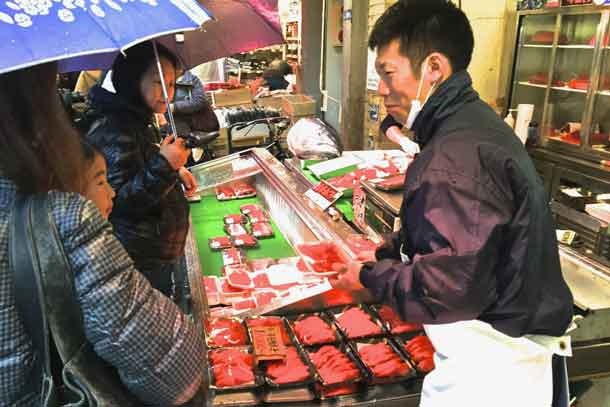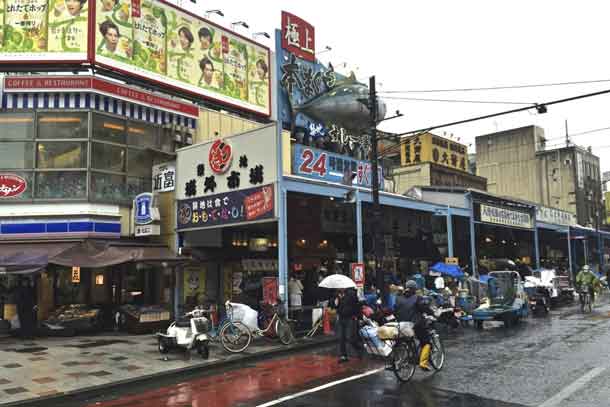

By David Latt – (Zester Daily)
TOKYO – TRAVEL – Located in central Tokyo, Tsukiji is the largest fish market in the world with separate wholesale and retail areas. Besides being the source for most of the fresh fish served in Tokyo’s sushi bars and restaurants, Tsukiji is the best food court imaginable.
On a recent trip to the market, like everyone else on the crowded sidewalk, I had come to see what wonderful ready-to-eat dishes were for sale. I didn’t know what I wanted, but I knew I would find something delicious at one of the closet-sized stalls.
In those tiny spaces, chefs stand close to customers as they prepare sushi and sashimi with freshly caught ingredients. Fat oysters steam in shinny stainless steel pots. Thick braids of smoke rise up from scallops and crabs cooking on blazingly hot grills. Tempura vegetables and shrimp sizzle in hot oil before arriving crisp and tender on a paper plate. Ramen noodles are drained and ladled into large bowls with servings of thick savory broth, topped with slices of sticky pork and half a hard-boiled egg.
The great variety of dishes available means a stall selling curry is a few steps from another selling shumai and pork-filled bao, and that stall is around the corner from a cook grilling skewered scallops topped with sea urchins.

I wanted to taste everything.
And yet, for all these wondrous treats, the city of Tokyo wants to tear down the market. The last time I visited, the city had slated Tsukiji for demolition. That the market was still open was a wonderful surprise.
Visiting Tsukiji this trip, I felt like I was seeing a long-lost friend. I brought my video camera to record what it is like to walk through the market before it is gone forever.
Urban progress, a culinary loss
So, if Tsukiji is so wonderful, why does the city want to tear it down?
The market occupies valuable real estate in a congested part of Tokyo. In a real estate-starved city, the market occupies acres of land that could be used to construct large building complexes that would bring in much needed revenue.
Tearing down the market would also eliminate the truck traffic in and out of the wholesale market. So it makes sense to move Tsukiji out of the city. On the other hand, removing Tsukiji is bad for tourism because every day thousands of people crowd the sidewalks and walkways inside the retail areas.
The conflict between these competing interests was all but resolved when the city spent $5.71 billion U.S. (¥588 billion) to construct a replacement facility in Toyosu, Koto, a suburb of Tokyo.
So why is the Tsukiji market still open?
The previous governor of Tokyo, Shintaro Ishihara, had made closing Tsukiji a priority. With the 2020 Olympics coming, the land was needed for other purposes and his administration said there were sanitary problems at an antiquated facility that opened in 1935.
When Yuriko Koike was elected governor in 2016, she reopened an inquiry into the cost overruns at the new Toyosu facility and she took seriously vendor complaints that rents at the new facility were considerably higher than at Tsukiji. So much higher that many preferred to go out of business rather than relocate to Toyosu.
Those issues were important, but what halted the demolition was something unexpected.
Remarkably, the Toyosu facility was constructed on landfill polluted by a gas plant, the previous tenant. Those health reasons were serious enough for Gov. Koike to halt the relocation of Tsukiji.
For now, the market is open for business. For how long is the question. A modified demolition has been proposed that would keep the retail part of the market where it is. The food stalls would continue to feed the many visitors and locals. The wholesale operation would move to Toyosu. But if that will happen and when are open questions. At the moment, Tsukiji’s demolition is still part of the city’s master plan.
If you are going to visit Tokyo, put Tsukiji at the top of your list of destinations to visit. Come hungry because you will want to sample the ready-to-eat food.
Allow several hours so you can explore the market without rushing. Absorb the sights and aromas of the market. Take it all in as if this were your last visit, because it just might be.
[youtube]https://www.youtube.com/watch?v=Bepat_JcO8E[/youtube]
Copyright 2017 David Latt via Zester Daily and Reuters Media Express






